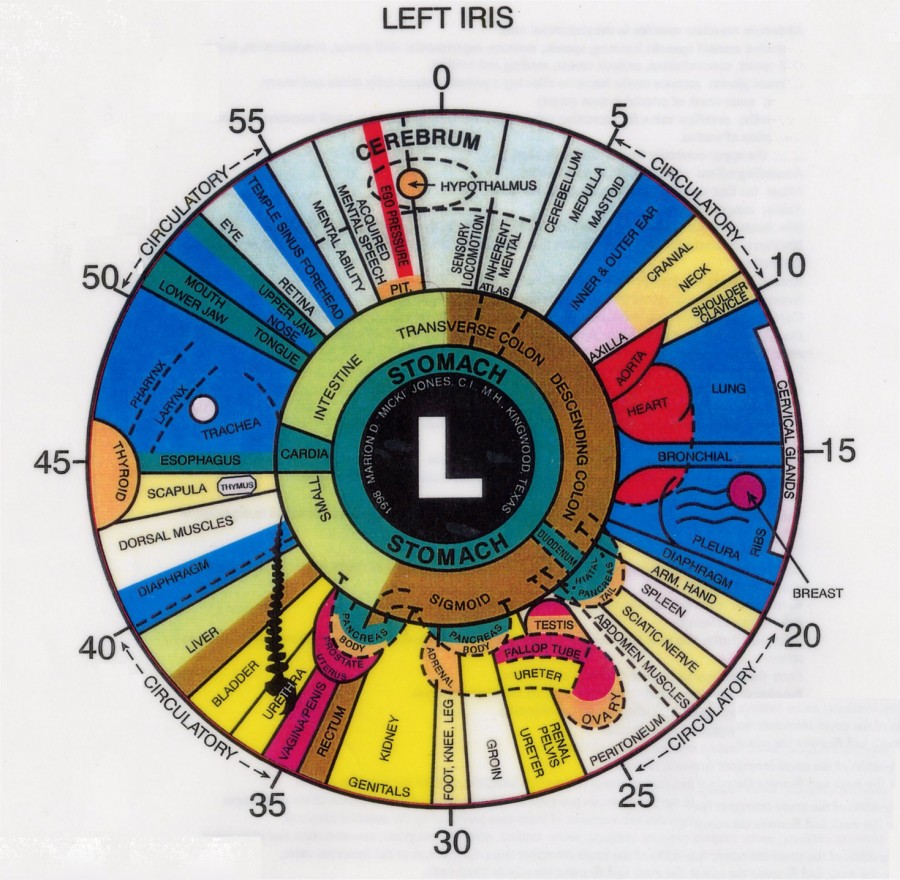Iridology
Iridology is a form of alternative medicine in which patterns, colors and other characteristics of stromal fibers of the iris are examined for information about a patient’s health. Practitioners match their observations to iris charts which divide the iris into many zones believed to be equivalent to specific parts of the human body. The iris is the greenish-yellow area surrounding the transparent pupil (showing as black). The white outer area is the sclera, the central transparent part of which is the cornea. The iris shows changing conditions of every part and organ of the human body. Every organ and part of the body is showed in the iris in a defined area. In addition, through various traces, signs, and discoloration in the iris, nature reveals inherited weaknesses and strengths.
Iridologists do not claim to be able to diagnose specific diseases, but to highlight those systems and organs in the body that are healthy and those which are, for example, overactive or inflamed. These are said to point to a tendency in the patient towards specific illnesses, to reflect past medical problems or to predict one’s health problems which may be developing.
Since iridology is not a method of treatment, its practitioners have often studied other branches of alternative medicine, such as naturopathy, homeopathy, yoga, ayurveda, and used the study of the iris as a diagnostic first step. Iridology is practiced more widely in Europe (especially in the UK and Germany), where there are approximately 20,000 practitioners, than in the United States, which has only a tenth of that number.
Methods
Iridologists generally use equipment such as a flashlight and magnifying glass, cameras or slit-lamp microscopes to examine a patient’s irises for tissue changes, as well as features such as specific pigment patterns and “irregular stromal architecture”. The markings and patterns are usually compared to an iris chart that correlates specific zones of the iris with specific parts of the body. Typical charts divide the iris into approximately 80-90 zones. For example, the zone corresponding to the kidney is often in the lower part of the iris just before 6 o’clock. However, iridologists use a number of different maps that do not necessarily agree with one another.
Details in the iris are supposed to reflect changes in the tissues of the corresponding body organs. For example, acute inflammatory, chronic inflammatory and catharral signs indicate involvement, maintenance, or healing of corresponding distant tissues, respectively. Other features that iridologists look for are contraction rings and Klumpenzellen, which are said to indicate various other health conditions, as interpreted in context.

Benefits
Practitioners of iridology point to the following benefits of iridology:
- Their examination is painless. The only thing patients have to tolerate is light being shone in the eyes.
- Iridologists aim to keep the patient well. They try to discover imbalances or weaknesses in the body before they develop into serious medical problems. Of course prevention of health problems is a central concept of all schools of medicine. Iridologists’ advice on how to keep the patient well is frequently good. For example, they may recommend a good diet, drinking plenty of water, and moderate exercise.
History
Examining a person’s eyes to help determine their health is an ancient practice dating back at least as far as the ancient Greeks.
The first explicit description of iridological principles such as homolaterality (without using the word iridology) are found in Chiromatica Medica, a famous work published in 1665 and reprinted in 1670 and 1691 by Philippus Meyeus (Philip Meyen von Coburg).
The first use of the word Augendiagnostik (“eye diagnosis,” loosely translated as iridology) began with Ignatz von Péczely, a 19th-century Hungarian physician. The most common story is that he got the idea for this diagnostic tool after seeing similar streaks in the eyes of a man he was treating for a broken leg and the eyes of an owl whose leg had broken many years before. At the First International Iridological Congress of Iridology, Ignaz von Péczely’s nephew, Dr August von Péczely, dismissed this myth as an apocryphal, and maintained that such claims were irreproducible.
German contribution in the Naturheilkunde field is due to a minister Pastor Felke, who developed a form of homeopathy for treating specific illnesses and described new iris signs in the early 1900s. However, Pastor Felke was subject to long and bitter litigation. The Pastor Felke Institute in Heimshiem, Germany was established as a leading center of iridologic research and training.
Iridology became also popular in the United States in the 1950s, when Bernard Jensen, an American chiropractor, began giving classes in his own method. This is in direct relationship with P. Johannes Thiel, Eduard Lahn (becoming an American under the name of Edward Lane) and J Haskell Kritzer. Jensen insisted on the body’s exposure to toxins, and the use of natural foods as detoxifiers.
